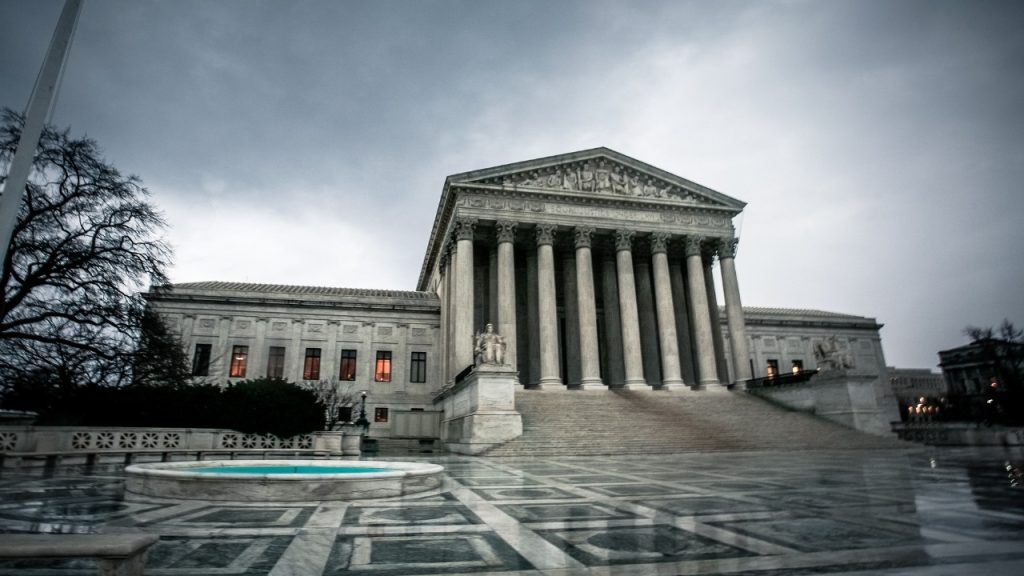Abortion and Insurance in a Post-Roe U.S.

The U.S. Supreme Court’s ruling June 24, 2022, in the case of Dobbs vs. Jackson, overturned five decades of abortion legal precedent established by the same court in the Roe vs. Wade decision in 1973, setting off a firestorm of backlash and praise from an increasingly divided electorate.
While the ruling undoubtedly will have intentional and unintentional repercussions as the question of whether abortion is a human right returns to state legislatures and courts to decide, our primary concern at the AgentSync blog is the fractured system of insurance, and how abortion coverage works – or doesn’t – within the framework of insurance.
No surprise: Insurance coverage for abortion was a patchwork of state frameworks and federal political footballs even before the Dobbs decision. From here, if we were to hazard a guess, we would project that things will get even more unevenerer.
SCOTUS ruling on the Dobbs decision
The full case name is Dobbs, State Health Officer of the Mississippi Department of Health, et al., vs. Jackson Women’s Health Organization et al., for anyone who is interested in reading the full 213-page opinion. At question was Mississippi’s Gestational Age Act, a law the Mississippi legislature passed in regular session that sought to limit abortion to the first 15 weeks of pregnancy, except for medical emergencies.
While the original text has sections of reasoning and definitions, professional sanctions and civil fines, the real crux of the law is the statement of Section 4:
“Abortion limited to fifteen (15) weeks’ gestation except in medical emergency and in cases of severe fetal abnormality.”
In a 6-3 decision, with Chief Justice John Roberts issuing a concurring opinion, SCOTUS (an acronym for the Supreme Court of the United States, for those of us who aren’t plagued by having constitutional lawyers in our social circles), decided to overturn the precedent previously set by cases such as Roe vs. Wade and Planned Parenthood vs. Casey, which affirmed a constitutional right to abortion. The Roe and Casey cases previously allowed states to set some parameters that curtailed abortion access for pregnancies that weren’t at the state of fetal viability – generally about 24 weeks, when a baby born prematurely is more likely than not to survive.
Roberts’ concurrence is notable in that, while he agreed with the decision to uphold Mississippi’s law, he disagreed with the overarching decision of the majority to completely overturn the Roe precedent.
With SCOTUS’s reversal of these precedents, the legality of abortion turns back to state legislatures and courts. Many states have strong laws protecting abortion as a right in their state constitutions, while others had “trigger laws” that went into effect immediately following the court’s decision that outright banned all abortion procedures other than for medical emergencies.
A brief history of the Roe vs. Wade precedent
In 1973, the Supreme Court ruled 7-2 that abortion before viability was protected by the U.S. Constitution in the case of Jane Roe, et al., Appellants, vs. Henry Wade. The precedent gave states some discretion to regulate in the second trimester of pregnancy, and wide latitude for state-based regulation in the third trimester.
Proponents and opponents alike point to the complete absence of any actual discussion or mention of pregnancy, abortion, menses, or general terminology around female anatomy of any kind in the Constitution and broader federal regulation. The precedent arose from what the court termed an “implied right to privacy” under the 14th Amendment. Specifically, Section 1 says:
“All persons born or naturalized in the United States, and subject to the jurisdiction thereof, are citizens of the United States and of the state wherein they reside. No state shall make or enforce any law which shall abridge the privileges or immunities of citizens of the United States; nor shall any state deprive any person of life, liberty, or property, without due process of law; nor deny to any person within its jurisdiction the equal protection of the laws.”
This passage concerning due process and equal protection, together with the Bill of Rights, the court said, implies the right to privacy for U.S. citizens, including the right to make personal medical decisions regarding bodily autonomy.
Prior to Roe, there wasn’t any U.S. federal approach concerning abortions. Some states had laws protecting abortion as a fundamental right; others – such as the Texas law that led to Roe – criminalized abortion for any reasons other than medical emergencies. Similarly, the end of Roe vs. Wade as the touchpoint precedent of the nation on abortion law leaves the regulatory framework of the states as a patchwork of defenses and bans.
Abortion and health insurance coverage
Unsurprisingly, even as Roe vs. Wade was the accepted precedential law of the land, insurance coverage and regulation of the procedure has been uneven. Multiple variables influence whether an abortion is covered under a health insurance policy.
- First, even prior to the Dobbs vs. Jackson SCOTUS decision, state rules affected what was or wasn’t covered by insurance policies regulated in those states. Some states mandated coverage, some states banned it, and others carved out exemptions for life-threatening conditions, rape, incest, or fetal impairment – this hasn’t changed.
- Second, the kind of insurance coverage a person has matters; Affordable Care Act marketplace plans (Obamacare), Medicare and Medicaid health plans, TriCare (military insurance), and employer-sponsored plans may follow different rules altogether even within the same state.
- Third, coverage depends on whether the Hyde Amendment is in effect.
While the overturn of Roe vs. Wade may galvanize state governments to further act to protect or ban abortion, the fundamental nature of insurance coverage for abortion is unlikely to change – barring Congressional action, it will remain a splinterwork of policy gaps.
What is the Hyde Amendment?
The Hyde Amendment is a policy provision that bans the use of federal funding for abortion other than in instances of rape, incest, or medical emergency. Congress votes every year to attach it as a rider to the annual budget appropriations bill for the Department of Health and Human Services.
By limiting federal funding for abortion, carriers that provide health insurance through the federal exchanges established by the Affordable Care Act (ACA) can’t cover most abortion procedures. However, states that protect abortion outright, such as Colorado or California, may have specialized funds specifically to ensure abortion coverage for ACA plans as well as for those covered through Medicare or Medicaid.
State treatments of insurer coverage of abortion
According to Guttmacher Institute, six states mandate that all private insurance plans cover abortion, sometimes prohibiting copays or co-insurance, or tying abortion coverage to maternal and prenatal coverage.
Several states don’t have definitive restrictions or protections one way or the other for insurer coverage of abortion, according to the Guttmacher chart.
Additionally, 11 states limit all private insurance plan coverage for abortions to scenarios that are medical emergencies, and half of states limit health care exchange plans to only cover abortion for medical emergencies, with many of them also allowing coverage for rape or incest, and sometimes covering abortion for fetal impairment.
Louisiana and Tennessee ban any insurer coverage for abortion outright, regardless of circumstance or medical need.
However, even limiting or prohibiting private insurance coverage of abortion doesn’t altogether end coverage of the procedure. Private insurance plans must follow both state and federal law, so if a state restricts insurer coverage of abortion, then a private insurer must follow the state law. But employers that self-insure, meaning they use an insurer for administrative services or for their established provider network but pay claims out of their own pockets, are only governed by the federal Employee Retirement and Income Security Act (ERISA), according to previous Supreme Court decisions. So, self-insured employer health plans may still choose to cover – or not – abortions for any variety of reasons, regardless of state legislation and policy regulation.
Another consideration as insurers and employers alike move forward is that, with more employees working across state lines, an employer plan may cover someone in a state with different abortion insurance laws. Other questions arise about whether self-insured employer plans might still cover procedures that are banned outright in their state, or whether they might set up a preferred provider network extension solely to provide this service through an out-of-state clinic where it’s legal.
If you’re reading this thinking it must be difficult for insurers to guess how to respond and when an organization is allowed, mandated, or prohibited from offering abortion as a covered service, you’re right. And, thanks to the Dobbs decision, this area of insurance regulation will only get murkier in the immediate future.
The future landscape of abortion laws
The Dobbs decision has lit a flame under both advocates of and opponents of abortion rights. The next several months (if not years) will likely involve a slew of headlines as voters, legislators, and judiciaries race to protect abortion or ban it.
Many states have trigger laws that have effectively banned abortion for any reason other than medical emergencies, but many courts are putting them on hold as lawsuits on behalf of patients seeking abortions work their way through the judicial system in these states.
Abortion-rights advocates in Congress are also trying to codify the procedure as a fundamental right in law instead of relying on the Supreme Court to determine the rights of the people through constitutional interpretation.
Lest anyone think there’s a chance this is “settled law” anywhere, consider that the Kansas Supreme Court determined the state constitution to protect the right to an abortion two years ago, effectively ending legislative attempts to curtail abortion procedures. So the state legislators have put the issue to the people, giving voters a special election decision Aug. 2, 2022, to vote whether the Kansas Constitution protects the right to abortion or whether voters want the Kansas Legislature to be able to “pass laws regarding abortion, including, but not limited to, laws that account for circumstances of pregnancy resulting from rape or incest, or circumstances of necessity when necessary to save the life of the mother.”
Meanwhile, employers have begun weighing in, with some announcing new policies to cover travel costs and abortion coverage regardless of what their health insurer covers through state-regulated policy.
The future is one of uncertainty. Will states lean into the stark and ever-widening political divide, splitting into a patchwork of red and blue with accordingly similar abortion laws? Will the increased awareness of the financial disparities and reproductive rights lead to a new era of welfare and justice? Will national unease with the Supreme Court decision lead to increased voter engagement and a more robust democracy?
Who the heck knows. Not us.
At AgentSync we’re committed to providing you with timely information on regulatory changes impacting the insurance industry. So committed, in fact, that we’ve built a Compliance Library where you can read up on existing regulations and keep abreast as things change.
If you’re looking for a better way to manage the ever-changing patchwork of state and federal insurance regulations, we can help with that too! Check out our solutions for producer onboarding and license compliance management.

